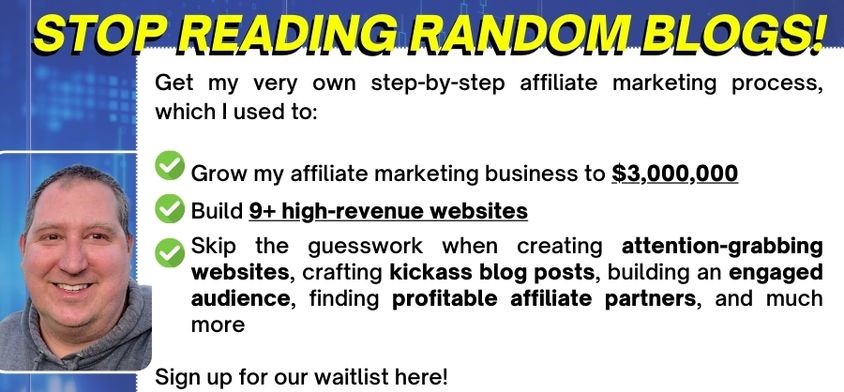If you’re starting to monetize your blog, you’re probably looking for ways to do it in a non-spammy way. After all, a lot of people think that bloggers who start to add advertisements and incorporate affiliate links into their posts have “sold out.”
You want to continue to keep your readers happy, but you’d also like to make some money off of your work, too.
Is it possible to do both?
Yes, it definitely is, and there are plenty of bloggers out there who have a strong affiliate marketing strategy. But it’s also painfully apparent when bloggers simply throw affiliate links into their writing in hopes to get clicks, not really putting much consideration into the product or service they’re promoting. There is a way to do it and then there’s a way to do it well.
First things first, you need to consider what type of products or services you should promote. This requires you to examine your ideal reader and the subject of your blog to figure out what types of things are best to feature. For people who start an online business as an affiliate marketer, this is called finding your niche. Do you blog about recipes and cooking, travel and destinations, or healthy, green living? Define who reads your blog and the subject matter you write about to determine the types of products and services that make sense for your reader. When you can predict their wants and needs, you’ll be able to translate that into sales.
Once you have a clearer idea of what exactly you’ll be interested in promoting, you can then create a game plan for putting those links on your blog. There certainly are no hard and fast rules here. But if you’re looking for a little bit of inspiration, you could try incorporating links in a few different ways, including…
Banners
Banner advertisements are probably the most commonly thought of way to earn affiliate revenue. And while they can certainly be effective, they can also be kind of annoying and make your site look less professional. There’s nothing worse than hopping onto a site and being bombarded with ads. Additionally, as more and more people read their blog content on RSS feeds, banners have become less valuable advertising methods.
That said, a well-curated selection of banners can be an easy way to monetize your blog. If you’ve got a solid design that focuses on great content, your readers will likely be interested to see the types of things you promote. Additionally, if you’ve paid particular attention to what you promote, then they won’t seem out of place at all. It’s when bloggers put banner ads that relate in no way to their content that it feels spammy and weird.
If you imagine that banner ads are simply unsightly boxes that appear in the sidebar, think again. Banners can appear underneath your header, in blog posts, at the end of posts, at the bottom of pages, or in a designated ads section of your site. Use trackable links and try out different locations to see what works best for you and what gets noticed the most.
Into Your Blog Posts
When you find yourself raving about a certain product or detailing your experience using a service, consider throwing in a link to it. If you’re discussing something and know about something that could help your reader even more, include this information. Any time you feel comfortable giving an honest opinion on tech equipment, a book, a pair of shoes, or whatever else fits into your niche, then make sure you insert an affiliate link.
This is definitely a great way for bloggers to get their feet wet with affiliate marketing. You can continue doing what it is you’ve always done (writing amazing blog posts) but you can do it slowly and at your own pace. Additionally, it is perfect for warming up your readers to the fact that you’re monetizing now. As I mentioned earlier, some readers might immediately roll their eyes when they see you’re starting to include affiliate links. But why shouldn’t you? Bloggers spend a lot of time getting their posts together, and it’s not crazy of you to turn your passion project into some revenue.
Where these types of links go awry is when people sprinkle them in hoping to get any clicks possible. Although your goal with monetization is obviously to make money, it shouldn’t be at the cost of good content. When readers start to sense that you’re simply throwing links at them and hoping they’ll take the bait rather than providing them with valuable information, you’ll notice a decline in readership.
On A Recommended Products Or Services Page
Some people will go to your site and want to know more about what type of equipment you use to shoot the amazing photographs on your blog, what travel credit cards you recommend, or the pans you always use when you’re baking. If you have a list of trusted products and services that you recommend wholeheartedly, consider setting up a page on your blog dedicated to that.
This can certainly feel a little sales-y—after all, it will likely end up being a page filled with affiliate links. However, if you do amazing work and put out content that your readers love, they will trust you and your opinions. People who truly value what you have to say will go to that page and feel comfortable buying every single thing, simply because it’s what you recommend.
On Your Social Media
If you simply don’t feel comfortable yet including links on your site, then consider using your social media platforms to get things going. In fact, if your ideal reader spends a lot of time on sites like Facebook, then this could work to your advantage! Regardless, your social media accounts are likely intertwined closely with your blog content, so it won’t seem out of place at all to include affiliate links in your status updates or tweets.
If you’ve got a small following still, then social media will only get you so far. Additionally, you’ll need to make sure you alternate your promotional affiliate links with other useful links that are not revolved around making sales. Readers want to feel like they’re getting valuable information from you and that will then build their trust in you—but you will certainly lose it if you only ever push products and services to them.
A solid affiliate marketing strategy will likely use more than one of these tactics. To decide what’s best for your blog, you truly need to look to your ideal reader. Examine their habits, social media preferences, and their interests to determine the best plan of action to monetize your blog.


